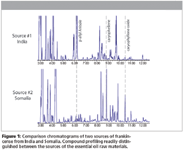Profiling of Essential Oil VOCs and SVOCs by GC–TMS
Spice and fragrance essential oil raw materials frankincense (Boswellia carterii) from India and Somalia, sandalwood (Santalum album) from India and Indonesia, and corn mint (Mentha haplocalyx) from the United States were analyzed for on-site analytical profiling and confirmation of quality and purity of therapeutic grade essential oils from raw materials.
Christopher R. Bowerbank1, Tai V. Truong2, Michael Vincent3, Ann M. Hoffman1, Milton L. Lee2, and Douglas W. Later1, 1 Torion Technologies Inc., 2 Brigham Young University, and 3 Rocky Mountain Oils
Acceptance of raw materials in food and fragrance industries historically is performed by sensory evaluation (taste, smell, appearance) without definitive analytical data to support quality control. Portable analytical instruments for on-site characterizationby gas chromatography/mass spectrometry have only recently become available. Product-specific volatile and semivolatile organic compounds (VOCs, SVOCs) can be used to verify the identification, source, or quality of a commodity. For rapid screening, a product profile containing marker compounds can be created to match against a new lot of material prior to acceptance. This pre-acceptance approval process has numerous benefits including decreased rejection rates due to counterfeit/bait-and-switch products. Coiled wire filament (CWF) sampling combined with portable gas chromatography-toroidal ion trap mass spectrometry (GC-TMS) is an effective tool for on-site analysis of VOCs and SVOCs at the point of origin or upon receipt of a commodity.

Figure 1
Experimental Conditions
Frankincense, sandalwood, and corn mint were provided by Rocky Mountain Oils (Springville, UT). Essential oil extracts were prepared by dissolution in dichloromethane (~1% v/v). Sampling was performed by placing the CWF into the sample solution, with ~1 μL uptake by capillary action. The solvent was evaporated in air for 5 s, and the CWF syringe was inserted into the GUARDION®-7 GC-TMS injection port, desorbing the target analytes into a low thermal mass injector (270 °C) coupled with a capillary GC column (MXT-5, 5 m × 0.1 mm, 0.4 μm df [Restek, Bellefonte, PA]). After an initial 30 s hold at 40 °C, the GC temperature was increased at 0.3 °C/s to 250 °C, with a final hold for 100 s. The capillary GC is coupled to a TMS detector with a mass range of 45–500 m/z.
Results
Figure 1 shows the GC-TMS chromatograms for two different sources of frankincense. Each sample is discernibly different based on the presence/absence of chemical compounds at specific retention times. Source #2 does not contain major compounds found at 6 min (p-allyl Anisole) and 10.2 min (caryophyllene oxide). Likewise, caryophellene (8.6 min) in source #2 is not found in as appreciable an amount as in source #1. This likely indicates that the samples are either from different sources, or that the original lot has undergone atypical aging or improper storage.
ConclusionsVOCs and SVOCs from essential oils can be quickly analyzed on-site using GC-TMS. Profiling of these compounds using the GUARDION-7 GC-TMS can support acceptance decisions of commodities at the source. The short GC-TMS analysis time allows the user to quickly analyze and evaluate multiple samples. VOC and SVOC marker screening can be used to verify raw material quality and/or identification.
Acknowledgements GUARDION® is a registered trademark of Torion Technologies Inc.

Torion Technologies Inc.
796 East Utah Valley Dr, Suite 200, American Fork, UT 84003
tel. (801)705-6600; fax (801)705-6649
Website: www.torion.com; Email: information@torion.com

SEC-MALS of Antibody Therapeutics—A Robust Method for In-Depth Sample Characterization
June 1st 2022Monoclonal antibodies (mAbs) are effective therapeutics for cancers, auto-immune diseases, viral infections, and other diseases. Recent developments in antibody therapeutics aim to add more specific binding regions (bi- and multi-specificity) to increase their effectiveness and/or to downsize the molecule to the specific binding regions (for example, scFv or Fab fragment) to achieve better penetration of the tissue. As the molecule gets more complex, the possible high and low molecular weight (H/LMW) impurities become more complex, too. In order to accurately analyze the various species, more advanced detection than ultraviolet (UV) is required to characterize a mAb sample.